
Wine Culture and Information since 2002 - Volume 22
 Wine Culture and Information since 2002 - Volume 22 |
|
Issue 240, June 2024 |
Contents |
|
|
The Numbers of Wine |
|
In recent months the world of wine seems to be quite eventful and news regarding its “health status” follows one another with a frequency, perhaps, never seen before. It is now well known that wine is not experiencing its best moment. Consumer preferences are changing, not only for cultural reasons in favor of new more or less healthy habits, but also due to the growing competition from “new drinks”, riding the success of current fads. Many of these drinks, evidently, contain alcohol, therefore the supposed health trend of these times does not seem to find a completely convincing response. It must also be said, in this regard, that since wine is among the most widespread and consumed alcoholic beverages in the world, when it comes to pointing the finger against alcohol consumption, it is inevitable that it is the first one to end up to the side of the guilty ones and therefore become the scapegoat. With all due respect to all other alcoholic drinks, including those with alcohol volumes much higher than that of wine. Wine consumption is decreasing, or rather, it is increasing. Young people's interest in wine has decreased, or rather not: they are crazy about the beverage of Bacchus. The export of Italian wine is in crisis, but no. I am very passionate about numbers but, unlike what happens in mathematics, those that have been read in recent months and relating to wine events seem to have decidedly bizarre behavior. Of course, statistics – which makes extensive use of mathematics – is based on its own principles and its numbers can be both irrefutable and questionable, depending on the basis and significant reliability of the sample examined. Sometimes, in fact, we read news that highlights simple percentages, without even mentioning either the sample examined or the sampling method. Easy journalistic tricks, one might say, simply reporting the evidence of a fact, completely ignoring its course and how it occurred. In short, in the same way as what the infamous “caption effect” produces when placed under an image which, as we all know, is worth a thousand words, although words often change the image. A few weeks ago a new study was presented about wine consumption in Italy, conducted by the UIV Observatory (Italian Wine Union) based on ISTAT (Italian National Institute of Statistics) data for the last 12 years. Specifically, the study compares the situation of wine consumption in Italy in 2023 in relation to the changes that have occurred over the last 12 years. The data presented in the study paint a picture in which it is clear that, in Italy, changes are taking place regarding consumption methods and habits, with a substantially unchanged percentage of consumers. Specifically, in 2023 wine was consumed by 29.4 million Italians, with the female share increasing. Habits and frequency of consumption are the factors that highlight the most substantial change: there is a tendency to favor occasional consumption and with greater awareness, probably also determined by health and legal considerations. In fact, daily wine consumers drop to 11.7 million, 400 thousand less than in 2022. Overall, during 2023, 23 million hectoliters of wine were consumed in Italy and – compared to 2011 – the number of consumers increased by 2%, despite however recording significant changes in habits. Italian consumers are represented by 58% of males and the remaining 42% of females; among new consumers, the percentage is higher in the female population than in the male population. The new wine consumers, however, seem to be characterized by greater responsibility and awareness, interested – not least – also in other alcoholic beverages, therefore not just wine. This habit does not only concern the new generations and is also quite common in adults who, among the other things, are increasingly moving away from the habit of daily consumption, even to accompany meals. The choice of consuming wine seems to be increasingly in favor of informal and social occasions, such as for example on the occasion of the so-called aperitif, which today represents the custom for almost 22 million Italians, with an increase of 31% compared to 2011. Furthermore, the changes with respect to gender are interesting: consumption demand has increased by 10% among the female population, while in the male population it drops by 3%. As already mentioned, daily consumption is also in sharp decline, marking a drop of 22% while the habit of occasional consumption increases by 20%, for a total of 17.7 million consumers equal to 60% of the total. A significant change when compared with what happened 12 years ago, when only 48% consumed wine occasionally. Sporadic consumption, however, is a habit that does not only concern wine as it also accounts for two thirds of the total among beer consumers. The daily consumption of wine, an important habit of Italians during meals until a few decades ago, is practically absent from the habits of consumers up to 24 years of age, accounting for only 4.4%, corresponding to approximately half of the total incidence. However, even older age groups recorded substantial declines – between -20% and -50% – while 40% of consumers over 65 maintain the habit of daily consumption. The UIV study also focuses on the distribution of consumers in the country, thus photographing the situation in the regions. The main share of consumers in Italy based on the regional population is found in Emilia-Romagna with 61.3%, followed by Valle d'Aosta with 60.5%. Tuscany follows with 60.4% then Veneto with 59.8%. As regards the major changes relating to the Italian provinces, Trento records the greatest increase of consumers in percentage terms with 11%, while – with regards to the major contraction in consumption on a regional basis – Basilicata records a decrease by 9%. Considering, however, the primary geographical subdivisions of the country, it is the North-East that records the highest percentage of consumers in relation to the population with 59.4%, followed by the Center, with 57.4%, then the North-West – with 56.7% – followed by the South with 51.1%, finally the Islands with 46.8%. From these data it emerges that it is the population over 65 to represent the primary segment of consumers, while the new generations, aged under 24, make the least share and, by considering the numbers, rather marginal. Furthermore, the complexity and variety of Italians' relationship with alcoholic beverages emerges which, compared to 12 years ago, does not mainly favor wine. In consumption, in fact, wine is forced to share the glass with beer and spirits, as well as other drinks with various alcoholic contents. This characteristic – it is worth noting – does not only concern young consumers but also adults and those over 65. In this regard, it is interesting to consider the consumption of beer, preferred by 27.2 million consumers, which has increased by 9.5% in the last 12 years, also recording the significant increase of 19% among occasional consumers. In overall terms of occasional consumption, the incidence among consumers of beer (66%) is higher than that of wine (60%). Contrary to what one might imagine, it is the over 65 age group that records the main increase (+103% in 12 years) while the 18-24 age group decreases by 4%. In both cases, however, it is the group of consumers over 65 who represent the primary share of consumption, while young people under 24 represent the minority share. Antonello Biancalana
|
||||
Contrasts of Asolo Prosecco Superiore Spumante Sui Lieviti Brut Nature and Franciacorta Dosaggio ZeroTwo sparkling wines produced with refermentation in the bottle, however from completely different grapes and techniques, including production times, with the only common quality of expressing recognizable personality in the glass. |
|
The production of sparkling wines by using the refermentation in the bottle certainly represents a method capable of giving the wines a strong personality, enriching them – not least – with rich and complex sensorial qualities. The process, in fact, is made up of numerous factors through which it is possible to obtain different results, both from an enological and sensorial point of view. Refermentation in the bottle – it must be noted – is not simply bottling a wine mixed with yeasts and sugars, then waiting for the result or the final magic, but rather an enological exercise which, first of all, requires competence, talent and technical precision. Including the ability to know the individual factors through which it is possible to “give life” to the final sparkling wine, starting from the grape – or grapes – when to proceed with the harvest and how to produce the so-called “wine base” to be used for the subsequent process of refermentation in the bottle. Grapes, technique, sugars, yeasts and, no less importantly, time, are just some of the fundamental factors taking part to the magic of creating bottled bubbles. Not all grapes are the same, of course, and therefore each grape will lead to the creation of a sparkling wine which is very different from any other and produced with other grapes. In this regard, it should also be noted that not all grapes are suitable for the production of sparkling wines refermented in the bottle and, many of these, undeniably make more exciting and expressive results through refermentation in a closed tank and for times usually shorter than those typical of refermentation in bottle. With some exceptions, of course. It must be said, in fact, there are grapes that produce sparkling wines – albeit with distinct and distant qualities – by using both methods. Glera, the variety with which Asolo Spumante is produced, is one of these. The same, however, can also be said for Pinot Noir and Chardonnay, two of the varieties used for the production of Franciacorta, despite being preferably made sparkling by refermentation in the bottle.
|
|
In the province of Treviso – in Veneto – the undisputed queen grape of the vineyards is certainly Glera, the variety with which almost all the bubbles of these lands are produced. Once known as Prosecco, in recent times and with the aim of better identifying and distinguishing grapes and wines, the name of the grape has been changed to Glera, leaving this term for the exclusive use of identifying the wine. Asolo is among the territories of the Veneto and the province of Treviso that stands out for the production of sparkling wines obtained from this grape, also reaching the highest quality level of the Italian system with the recognition of the Denominazione d'Origine Controllata e Garantita (Denomination of Controlled and Guaranteed Origin, DOCG). The production of sparkling wines in this area is normally carried out in a closed tank, therefore with the Charmat or Martinotti method, and this is how the majority of the bottles of the denomination are made. The production disciplinary also provides for the use of refermentation in the bottle and, when used, must be indicated on the label. The disciplinary, in fact, provides for the production of Asolo Prosecco Superiore by refermentation in the bottle without the separation of fermentation lees, a characteristic which, according to how the wine is poured and served, influences the organoleptic qualities of the wine. This production method must be signaled in the lables with the term “sui lieviti” (on yeast lees), thus signaling the presence of sediment inside the bottle. According to the disciplinary, the base wines to be refermented in the bottle must belong to a single harvest, the refermentation must take place between 1 March and 30 June following the harvest, with a final overpressure in the bottle not exceeding 0.5 atmospheres. The wine thus obtained must be commercialized only in the “Brut Nature” style – or similar mention – and after a minimum period of 90 days of refermentation in the bottle. As regards the service, there are two distinct “schools”. Some prefer to serve it by resuspending the sediment – thus obtaining a hazy appearance and a richer sensorial profile – while others pour it into the glass by paying scrupulous attention to leaving the sediment at the bottom of the bottle, thus serving a limpid wine.
|
||||
|
Franciacorta was the first Italian wine denomination to achieve recognition of the Denominazione d'Origine Controllata e Garantita (Denomination of Controlled and Guaranteed Origin, DOCG) for the production of classic method sparkling wines. It was in fact 1995 when Franciacorta obtained this recognition, after that of the Denominazione d'Origine Controllata (Denomination of Controlled Origin, DOC) in 1967. Franciacorta extends in the province of Brescia, south of Lake Iseo and its traditions about the production of vini mordaci – this is how wines with bubbles were often called in past centuries in Italy, literally biting wines – is widely documented. Franciacorta, undeniably, has represented a successful production and association model among the first in Italy, also constituting a reference for the other denominations of the country. In fact, we must note the common and shared determination of all producers in pursuing and achieving quality viticultural methods for the benefit of the entire territory, therefore for the entire denomination, and ultimately for the advantage of each producer. At the base of all the sparkling wines of Franciacorta are Chardonnay, Pinot Noir and Pinot Blanc varieties, among the most appreciated ones for the production of classic method sparkling wines. The production process involves the creation of a base wine which will then be sent to the second fermentation inside a bottle, after mixing it with yeasts and sugar. The production disciplinary provides for the Bianco, Rosé and Satèn styles, the latter characterized by a lower overpressure in the bottle compared to the other styles, in order to make it taste, so to speak, more creamy and velvety. An interesting quality of the production process of Franciacorta is represented by the minimum time of refermentation and aging in the bottle on its yeasts which, according to the disciplinary, must be at least 18 months, a much longer time than many other classic method wines in the world. This time is significantly increased in the case of millesimati – 30 months – and riserva styles, for which a minimum time of 60 months is required. At the end of this period, the bottles are disgorged and then filled with a mixture of wine and sugars, according to each style. Franciacorta Dosaggio Zero, which we examine in our tasting, does not make use of the addition of sugary blends, thus obtaining an absolutely dry and, so to speak, pure sparkling wine and not affected by subsequent production processes. In this regard, it must be noted that this style can also be identified on the label with similar mentions, including Pas Dosé, Nature and Dosage Zero.
|
The wines from this month's tasting by contrast are easily available in any wine shop, as their bottles enjoy good production levels and, therefore, easily found on the market. Of the two, the wine that could possibly represent the greatest difficulty is the Asolo Prosecco Superiore Spumante Sui Lieviti Brut Nature, however a well-stocked wine shop will certainly be the best place to make the purchase. As regards the Venetian sparkling wine, we will ensure that it is produced exclusively with Glera grapes, considering that – according to the disciplinary – this can be present for a minimum of 85%. In this regard, it must be said that the majority of producers tend to make their Asolo Prosecco Superiore with 100% Glera, however, it is good to be sure about this. As regards Franciacorta Dosaggio Zero, we will opt for a bottle produced with the majority of Pinot Noir and the remaining part of Chardonnay. Regarding the vintages, for the Asolo Prosecco Superiore Spumante Sui Lieviti Brut Nature the latest current vintage will be chosen, while for the Franciacorta Dosaggio Zero we will opt for a “non-vintage”, that is without vintage. Both wines are served in tasting glasses at a temperature of 10 °C. (50 °F) Let's start the tasting and proceed with the evaluation of the appearance of the two wines, by examining the glass of the Asolo Prosecco Superiore Spumante Sui Lieviti Brut Nature. By holding the glass in a vertical position and without swirling, let's observe the wine from above in order to evaluate the superficial movement of the bubbles and the crown. The formation of foam around the edge of the wine, in correspondence with the inner side of the glass, is good and with fairly thin bubbles. Let's now observe the development of the bubbles from the base of the glass towards the surface: we can see persistent chains of thin bubbles and in good number. The color of Venetian wine is intense greenish yellow with a nuance that confirms the same hue. In case the wine is served with its sediment, the appearance will also be evidently hazy. Observing the crown of Franciacorta Dosaggio Zero allows us to see a formation of finer foam and bubbles compared to the previous wine, as well as the development of bubbles from the base. The color of the Lombard sparkling wine reveals a strong bright straw yellow color, a hue which is confirmed – also in this case – in the nuance. Although the two wines are produced by refermentation in the bottle, the olfactory profiles of Asolo Prosecco Superiore Spumante Sui Lieviti Brut Nature and Franciacorta Dosaggio Zero are considerably different. This is not only because of the olfactory characteristics of the respective grapes – which, in any case, contribute to the overall composition – but also to all the other factors typical of the production of sparkling wines refermented in the bottle. Time is certainly one of these, a factor which, not least, allows yeasts and their degradation to confer their aromatic qualities on the wine. In this sense, the bottle that evidently suffers the greatest influence of yeasts is certainly Franciacorta Dosaggio Zero, for which a minimum period of 18 months is required. On the nose, the contribution of yeasts is however clearly perceptible in both wines, obviously in a different way and with a distinct impact. These wines, of course, are not just yeasts and, in both cases, the olfactory qualities of the respective grapes are clearly perceptible, considering in any case that in the Asolo Prosecco Superiore Spumante Sui Lieviti Brut Nature it will also be perceived a stronger sensation of “young olfactory freshness” of flowers and fruits. Let's continue this month's tasting by contrast and proceed with the analysis of the olfactory profiles of the two wines, starting from the Asolo Prosecco Superiore Spumante Sui Lieviti Brut Nature. Let's hold the glass in vertical position and, without swirling, proceed with the first smell in order to appreciate the opening of the wine, that is, the expression of its primary and identifying aromas. From the glass we appreciate aromas of pear, apple and wisteria to which is added the pleasing scent of bread crust, a clear contribution of the yeasts during refermentation in the bottle. Let's now swirl the glass, in order to favor the development of the other aromas, and do the second smell. The profile of Asolo Prosecco Superiore Spumante Sui Lieviti Brut Nature is completed with peach, pineapple, hawthorn, tangerine, plum and banana, as well as a hint of almond. Let's now move on to the evaluation of Franciacorta Dosaggio Zero and proceed with the analysis of its opening. From the glass can be perceived aromas of apple, banana, plum and bread crust, the latter more intense and “rich” than the previous wine. After having swirled the glass and carried out the second smell, the olfactory profile of Franciacorta Dosaggio Zero is completed with hawthorn, tangerine, grapefruit, hazelnut, pear and pineapple. Let's now move on to the evaluation of the gustatory profiles of the wines, starting from the examination of the attack of the Asolo Prosecco Superiore Spumante Sui Lieviti Brut Nature. Let's take a sip of this wine which will immediately make us appreciate the lively effervescence supported by a clear and sharp crispness given by the acidity. The balance is obtained thanks to the effect of alcohol – which in these wines is generally present in modest quantities – in addition to a hint of pleasing creamy roundness given by the yeasts and the refermentation in the bottle. We can clearly perceive in the mouth the flavors of pear, apple, pineapple and tangerine. Let's proceed with the evaluation of the gustatory profile of Franciacorta Dosaggio Zero, starting from its attack. In the mouth we can immediately perceive the effervescence produced by the carbon dioxide – less aggressive than the previous wine – and the clear sensation of crispness given by the acidity. The balance is obtained thanks to the alcohol – generally higher than Asolo Prosecco Superiore – and the roundness given by the refermentation in the bottle, more accentuated than the previous wine. In the mouth can be perceived the flavors of apple, plum, banana and grapefruit. We have reached the end of our tasting, therefore we proceed with the evaluation of the final sensations perceived in the mouth after swallowing. The finish of the Asolo Prosecco Superiore Spumante Sui Lieviti Brut Nature is persistent and in the mouth we can continue to perceive its marked acidity as well as the flavors of pear, apple, pineapple and tangerine. The finish of Franciacorta Dosaggio Zero is equally persistent and, compared to Asolo Prosecco Superiore, in the mouth is perceived a sensation of fuller structure in addition to the evident sharp crispness given by the acidity. In the mouth we also perceive the flavors of apple, plum, banana and grapefruit. The role of the refermentation time in the bottle is at this point evident in terms of sensorial qualities, differentiating the two wines – in addition to the grapes used for their production – also in terms of sensorial complexity and structure. The role of yeasts in relation to the refermentation time can still be clearly perceived by the nose, first smelling the glass of Asolo Prosecco Superiore and then Franciacorta Dosaggio Zero.
|
||||||||
Wines of the Month |
|
|
|
Score legend Prices are to be considered as indicative. Prices may vary according to the country or the shop where wines are bought |

|
|
Serrapetrona Pepato 2021 |
|
| Fontezoppa (Marches, Italy) | |
 Vernaccia Nera Vernaccia Nera | |
| Price: € 18.00 | Score: |
 Intense ruby red and nuances of garnet red, little transparency. Intense ruby red and nuances of garnet red, little transparency. Intense, clean, pleasing and refined, starts with hints of black
cherry, plum and strawberry followed by aromas of dried violet, blackberry,
blueberry, raspberry, black pepper, laurel, vanilla and menthol. Intense, clean, pleasing and refined, starts with hints of black
cherry, plum and strawberry followed by aromas of dried violet, blackberry,
blueberry, raspberry, black pepper, laurel, vanilla and menthol.
 Properly tannic attack and however balanced by alcohol, good body,
intense flavors, agreeable. Properly tannic attack and however balanced by alcohol, good body,
intense flavors, agreeable.
 Persistent finish with flavors of black cherry, plum and strawberry. Persistent finish with flavors of black cherry, plum and strawberry. 12 months in cask. 12 months in cask. |
|
 Stuffed pasta with meat and mushrooms, Broiled meat and barbecue, Roasted meat, Stewed meat with mushrooms Stuffed pasta with meat and mushrooms, Broiled meat and barbecue, Roasted meat, Stewed meat with mushrooms |
|
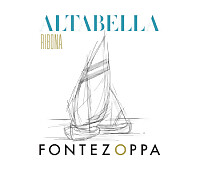
|
|
Colli Maceratesi Ribona Altabella 2022 |
|
| Fontezoppa (Marches, Italy) | |
 Maceratino Maceratino | |
| Price: € 21.00 | Score: |
 Intense straw yellow and nuances of golden yellow, very transparent. Intense straw yellow and nuances of golden yellow, very transparent. Intense, clean, pleasing and refined, starts with hints of apple, plum
and hawthorn followed by aromas of broom, peach, peach, citrus fruits,
anise, linden and mineral. Intense, clean, pleasing and refined, starts with hints of apple, plum
and hawthorn followed by aromas of broom, peach, peach, citrus fruits,
anise, linden and mineral.
 Crisp attack and however balanced by alcohol, good body, intense
flavors, agreeable. Crisp attack and however balanced by alcohol, good body, intense
flavors, agreeable.
 Persistent finish with flavors of plum, apple and peach. Persistent finish with flavors of plum, apple and peach. Aged in steel tanks. Aged in steel tanks. |
|
 Pasta with fish, Stewed white meat, Stewed fish with mushrooms, Roasted fish Pasta with fish, Stewed white meat, Stewed fish with mushrooms, Roasted fish |
|
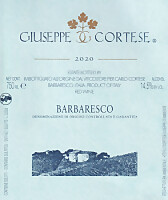
|
|
Barbaresco 2020 |
|
| Giuseppe Cortese (Piedmont, Italy) | |
 Nebbiolo Nebbiolo | |
| Price: € 35.00 | Score: |
 Brilliant ruby red and nuances of garnet red, moderate transparency. Brilliant ruby red and nuances of garnet red, moderate transparency. Intense, clean, pleasing, refined and elegant, starts with hints of
cherry, plum and violet followed by aromas of rose, raspberry, strawberry,
cocoa, tobacco, thyme, mace, leather, licorice, vanilla and menthol. Intense, clean, pleasing, refined and elegant, starts with hints of
cherry, plum and violet followed by aromas of rose, raspberry, strawberry,
cocoa, tobacco, thyme, mace, leather, licorice, vanilla and menthol.
 Properly tannic attack and however balanced by alcohol, full body,
intense flavors, pleasing crispness. Properly tannic attack and however balanced by alcohol, full body,
intense flavors, pleasing crispness.
 Persistent finish with flavors of cherry, plum and raspberry. Persistent finish with flavors of cherry, plum and raspberry. 18 months in cask, at least 6 months in bottle. 18 months in cask, at least 6 months in bottle. |
|
 Game, Roasted meat, Stewed and braised meat with mushrooms, Hard cheese Game, Roasted meat, Stewed and braised meat with mushrooms, Hard cheese |
|

|
|
Chianti Classico Riserva 2020 |
|
| Riecine (Tuscany, Italy) | |
 Sangiovese Sangiovese | |
| Price: € 45.00 | Score: |
 Brilliant ruby red and nuances of ruby red, little transparency. Brilliant ruby red and nuances of ruby red, little transparency. Intense, clean, pleasing, refined and elegant, starts with hints of
black cherry, plum and raspberry followed by aromas of violet, rose,
blueberry, red orange, chocolate, tobacco, cinnamon, licorice, mace,
vanilla and menthol. Intense, clean, pleasing, refined and elegant, starts with hints of
black cherry, plum and raspberry followed by aromas of violet, rose,
blueberry, red orange, chocolate, tobacco, cinnamon, licorice, mace,
vanilla and menthol.
 Properly tannic attack and however balanced by alcohol, good body,
intense flavors, agreeable. Properly tannic attack and however balanced by alcohol, good body,
intense flavors, agreeable.
 Persistent finish with flavors of black cherry, plum and raspberry. Persistent finish with flavors of black cherry, plum and raspberry. 24 months in cask, 3 months in bottle. 24 months in cask, 3 months in bottle. |
|
 Roasted meat, Stewed meat with mushrooms, Broiled meat and barbecue, Cheese Roasted meat, Stewed meat with mushrooms, Broiled meat and barbecue, Cheese |
|

|
|
Tre Sette 2018 |
|
| Riecine (Tuscany, Italy) | |
 Merlot Merlot | |
| Price: € 80.00 | Score: |
 Intense ruby red and nuances of garnet red, little transparency. Intense ruby red and nuances of garnet red, little transparency. Intense, clean, pleasing, refined and elegant, starts with hints of
black currant, plum and dried violet followed by aromas of iris, black
cherry, blueberry, raspberry, cocoa, tobacco, cardamom, mace, face powder,
licorice, leather, graphite, vanilla and eucalyptus. Intense, clean, pleasing, refined and elegant, starts with hints of
black currant, plum and dried violet followed by aromas of iris, black
cherry, blueberry, raspberry, cocoa, tobacco, cardamom, mace, face powder,
licorice, leather, graphite, vanilla and eucalyptus.
 Properly tannic attack and however balanced by alcohol, full body,
intense flavors, pleasing roundness. Properly tannic attack and however balanced by alcohol, full body,
intense flavors, pleasing roundness.
 Persistent finish with flavors of black currant, plum and black cherry. Persistent finish with flavors of black currant, plum and black cherry. 24 months in cask, 6 months in bottle. 24 months in cask, 6 months in bottle. |
|
 Game, Roasted meat, Stewed and braised meat, Hard cheese Game, Roasted meat, Stewed and braised meat, Hard cheese |
|
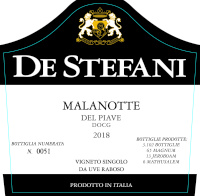
|
|
Malanotte del Piave 2019 |
|
| De Stefani (Veneto, Italy) | |
 Raboso Raboso | |
| Price: € 40.50 | Score: |
 Intense ruby red and nuances of garnet red, little transparency. Intense ruby red and nuances of garnet red, little transparency. Intense, clean, pleasing, refined and elegant, starts with hints of
plum, black cherry and dried violet followed by aromas of dried rose,
blueberry, blackberry, cocoa, tobacco, licorice, leather, mace, vanilla and
menthol. Intense, clean, pleasing, refined and elegant, starts with hints of
plum, black cherry and dried violet followed by aromas of dried rose,
blueberry, blackberry, cocoa, tobacco, licorice, leather, mace, vanilla and
menthol.
 Properly tannic attack and however balanced by alcohol, full body,
intense flavors, agreeable. Properly tannic attack and however balanced by alcohol, full body,
intense flavors, agreeable.
 Persistent finish with flavors of plum, black cherry and blueberry. Persistent finish with flavors of plum, black cherry and blueberry. 36 months in barrique, 18 months in bottle. 36 months in barrique, 18 months in bottle. |
|
 Game, Roasted meat, Broiled meat and barbecue, Stewed and braised meat, Cheese Game, Roasted meat, Broiled meat and barbecue, Stewed and braised meat, Cheese |
|
|
|
|
Colli di Conegliano Refrontolo Rosso Stèfen 1624 2018 |
|
| De Stefani (Veneto, Italy) | |
 Marzemino Marzemino | |
| Price: € 82.00 | Score: |
 Intense ruby red and nuances of garnet red, little transparency. Intense ruby red and nuances of garnet red, little transparency. Intense, clean, pleasing, refined and elegant, starts with hints of
black cherry, blackberry and dried violet followed by aromas of dried rose,
raspberry, plum, blueberry, chocolate, cinnamon, tobacco, face powder, pink
pepper, mace, leather, vanilla and menthol. Intense, clean, pleasing, refined and elegant, starts with hints of
black cherry, blackberry and dried violet followed by aromas of dried rose,
raspberry, plum, blueberry, chocolate, cinnamon, tobacco, face powder, pink
pepper, mace, leather, vanilla and menthol.
 Properly tannic attack and however balanced by alcohol, good body,
intense flavors, pleasing roundness. Properly tannic attack and however balanced by alcohol, good body,
intense flavors, pleasing roundness.
 Very persistent finish with long flavors of black cherry, blackberry
and raspberry. Very persistent finish with long flavors of black cherry, blackberry
and raspberry.
 36 months in barrique, 18 months in bottle. 36 months in barrique, 18 months in bottle. |
|
 Roasted meat, Broiled meat and barbecue, Stewed meat with mushrooms, Hard cheese Roasted meat, Broiled meat and barbecue, Stewed meat with mushrooms, Hard cheese |
|
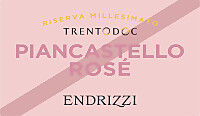
|
|
Trento Rosé Riserva Brut Piancastello 2018 |
|
| Endrizzi (Trentino, Italy) | |
 Pinot Nero, Chardonnay Pinot Nero, Chardonnay | |
| Price: € 23.00 | Score: |
 Intense onion skin pink and nuances of onion skin pink, transparent,
fine and persistent perlage. Intense onion skin pink and nuances of onion skin pink, transparent,
fine and persistent perlage.
 Intense, clean, pleasing, refined and elegant, starts with hints of
cherry, raspberry and bread crust followed by aromas of cyclamen, pink
grapefruit, hawthorn, pink grapefruit, tangerine, strawberry, apple, plum,
praline, croissant, mineral and hints of vanilla. Intense, clean, pleasing, refined and elegant, starts with hints of
cherry, raspberry and bread crust followed by aromas of cyclamen, pink
grapefruit, hawthorn, pink grapefruit, tangerine, strawberry, apple, plum,
praline, croissant, mineral and hints of vanilla.
 Effervescent and crisp attack, however balanced by alcohol, good body,
intense flavors, agreeable. Effervescent and crisp attack, however balanced by alcohol, good body,
intense flavors, agreeable.
 Persistent finish with flavors of cherry, raspberry and pink
grapefruit. Persistent finish with flavors of cherry, raspberry and pink
grapefruit.
 Part of the base wine is fermented in barrique. Refermented in bottle
on its lees for at least 48 months. Part of the base wine is fermented in barrique. Refermented in bottle
on its lees for at least 48 months.
|
|
 Stuffed pasta, Roasted white meat, Roasted fish, Mushroom soups Stuffed pasta, Roasted white meat, Roasted fish, Mushroom soups |
|
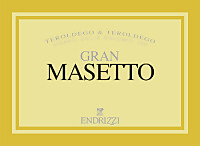
|
|
Gran Masetto 2019 |
|
| Endrizzi (Trentino, Italy) | |
 Teroldego Teroldego | |
| Price: € 49.00 | Score: |
 Deep ruby red and nuances of garnet red, little transparency. Deep ruby red and nuances of garnet red, little transparency. Intense, clean, pleasing, refined and elegant, starts with hints of
black cherry, plum and blackberry followed by aromas of dried violet,
blueberry, chocolate, tobacco, cinnamon, face powder, leather, licorice,
mace, graphite, vanilla and menthol. Intense, clean, pleasing, refined and elegant, starts with hints of
black cherry, plum and blackberry followed by aromas of dried violet,
blueberry, chocolate, tobacco, cinnamon, face powder, leather, licorice,
mace, graphite, vanilla and menthol.
 Properly tannic attack and however balanced by alcohol, full body,
intense flavors, pleasing roundness. Properly tannic attack and however balanced by alcohol, full body,
intense flavors, pleasing roundness.
 Very persistent finish with long flavors of black cherry, plum and
blackberry. Very persistent finish with long flavors of black cherry, plum and
blackberry.
 20 months in barrique, 6 months in bottle. 20 months in barrique, 6 months in bottle. |
|
 Game, Roasted meat, Stewed and braised meat, Hard cheese Game, Roasted meat, Stewed and braised meat, Hard cheese |
|
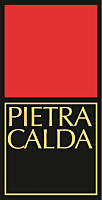
|
|
Fiano di Avellino Pietracalda 2022 |
|
| Feudi di San Gregorio (Campania, Italy) | |
 Fiano Fiano | |
| Price: € 14.50 | Score: |
 Brilliant straw yellow and nuances of straw yellow, very transparent. Brilliant straw yellow and nuances of straw yellow, very transparent. Intense, clean, pleasing, refined and elegant, starts with hints of
apple, citron and hawthorn followed by aromas of chamomile, broom,
pineapple, pear, medlar, peach, plum, hazelnut, linden and rosemary. Intense, clean, pleasing, refined and elegant, starts with hints of
apple, citron and hawthorn followed by aromas of chamomile, broom,
pineapple, pear, medlar, peach, plum, hazelnut, linden and rosemary.
 Crisp attack and however balanced by alcohol, good body, intense
flavors, agreeable. Crisp attack and however balanced by alcohol, good body, intense
flavors, agreeable.
 Persistent finish with flavors of apple, citron and pineapple. Persistent finish with flavors of apple, citron and pineapple. 5 months in steel tanks. 5 months in steel tanks. |
|
 Pasta with fish, Fried fish, Stewed white meat and fish, Legume soups Pasta with fish, Fried fish, Stewed white meat and fish, Legume soups |
|
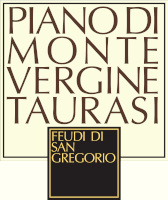
|
|
Taurasi Riserva Piano di Montevergine 2016 |
|
| Feudi di San Gregorio (Campania, Italy) | |
 Aglianico Aglianico | |
| Price: € 35.00 | Score: |
 Intense ruby red and nuances of garnet red, little transparency. Intense ruby red and nuances of garnet red, little transparency. Intense, clean, pleasing, refined and elegant, starts with hints of
plum, blackberry and dried violet followed by aromas of dried rose, black
cherry, blueberry, cocoa, rhubarb, tobacco, cinnamon, leather, licorice,
mace, graphite, vanilla and menthol. Intense, clean, pleasing, refined and elegant, starts with hints of
plum, blackberry and dried violet followed by aromas of dried rose, black
cherry, blueberry, cocoa, rhubarb, tobacco, cinnamon, leather, licorice,
mace, graphite, vanilla and menthol.
 Properly tannic attack and however balanced by alcohol, full body,
intense flavors, agreeable. Properly tannic attack and however balanced by alcohol, full body,
intense flavors, agreeable.
 Very persistent finish with long flavors of plum, blackberry and black
cherry. Very persistent finish with long flavors of plum, blackberry and black
cherry.
 24 months in barrique and cask, 24 months in bottle. 24 months in barrique and cask, 24 months in bottle. |
|
 Game, Roasted meat, Braised and stewed meat, Hard cheese Game, Roasted meat, Braised and stewed meat, Hard cheese |
|
News |
|
In this section are published news and information about events concerning the world of wine and food. Whoever is interested in publishing this kind of information can send us a mail to our address.
|
AquavitaeReview of Grappa, Distillates and Brand |
|
|
||||||||||||||||||||||||
Wine Guide ParadeMarch 2024
|
| |||||||
Privacy Policy | |||||||


| Copyright © 2002-2024 Antonello Biancalana, DiWineTaste - All rights reserved |
| All rights reserved under international copyright conventions. No part of this publication and of this WEB site may be
reproduced or utilized in any form or by any means, electronic or mechanical, without permission in writing from DiWineTaste. |